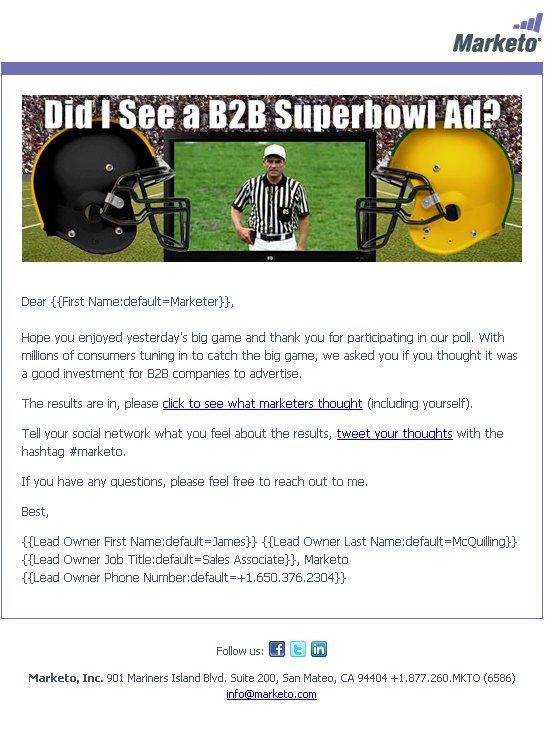 The Super Bowl isn’t only the Super Bowl of football, but the Super Bowl of marketing as well.
The Super Bowl isn’t only the Super Bowl of football, but the Super Bowl of marketing as well.
Big splashy ads. Massive media spends. And tons of buzz in the media, both print and social.
Ah, but pity the poor B2B marketer. While she can probably find the budget to land a spot on the big game (most memorable for me – the EDS cowboys and their cat herding adventures), she isn’t selling sodas or cars, so she can’t get a big-name celebrity to pitch industrial plumbing equipment or enterprise telephone software.
Or can she? Salesforce.com hired The Black Eyed Peas (personally, the first person that come to my mind when I think of a real-time, enterprise collaboration platform is apl.de.ap) in its recent Super Bowl spots. Sounds like a lot of fun, but was there ROI? Considering they spent “big numbers” it’s quite hard to judge.
Jujitsu Marketing
Aside from having big numbers and black-eyed peas on your side, can your B2B marketing efforts benefit from a major consumer event like the Super Bowl? I’d argue, yes. For the sake of this blog post, and to parrot every other marketing blogger who is much better than me at branding their own terms, let’s call these attempts Jujitsu Marketing (perhaps a subset of real-time marketing).
In case you’re not familiar, jujitsu is a martial art designed to use an (often better equipped) enemy’s energy against him, instead of directly fighting it. Jujitsu Marketing (and I’m just making this up off the top of my head, as I type so there are no hard and fast rules) uses the energy created by a (most likely) larger marketer in the consumer realm to grab some B2B attention and buzz.
Here are two examples, one for Enterprise and one for SMB B2B marketers. One example leverages a partner’s energy, the other example leverages a competitor.
ENTERPRISE B2B MARKETING: USING EMAIL TO ENGAGE B2B AUDIENCE ON A SUNDAY
As I mentioned above, BEP was selling B2B during SB XLV. What I saw as bizarre, the always clever marketers at Marketo saw as a marketing opportunity to ask their email list if this was, in fact, bizarre.
“A few of my colleagues read that Salesforce.com had purchased commercial slots during the Super Bowl halftime show one week before airtime. We were impressed that Salesforce.com would invest millions of dollars to promote Chatter.com via a medium dominated by B2C companies,” remarked Shonal Narayan, Manager, Marketing Programs, Marketo.
“Having this prior knowledge, we debated amongst ourselves if this [email send] was a good investment. Feeling compelled to ask what other marketers would think about the ad, we came up with the idea of a poll right after the ads aired live, so it was still fresh in people’s minds.”
click image to enlarge

There were two landing pages to confirm to recipients that the poll voting had been captured, one for the “yes” and one for the “no.”
Narayan’s team followed up with a results email the next day to everyone that participated in the poll. It drove people to a landing page that encourage people to tweet. The landing pages for the initial email send were also redirected to the results URL, so anybody clicking the initial poll email after the results were sent would see the results from the poll.
click image to enlarge

Keep mobile in mind
When leveraging a consumer event, keep in mind that your B2B audience likely doesn’t have a bulky gray Dell on their lap when engaging in the activity.
“[We] ultimately decided to use a single-click poll embedded within the email to make it easy for the people viewing the email on their mobile device. Just a simple ‘click yes or no’,” Narayan said.
The results: Marketo, B2B Super Bowl advertising win
“We conduct many A/B tests, and we’ve found that Sunday emails (especially P.M. sends) do not perform well. However, this campaign did particularly well. We wanted to give a buffer after the halftime ads had been shown, so I scheduled it to send at 5:40pm PT,” Narayan said.
Here are the results from Narayan’s team:
- Email sent to more than 20,000 marketers in the US and Canada.
- 13.5% open rate, yielding a 16.5% click to open rate.
- More than 680 respondend to the poll (which is more than the initial click performance reveals, indicating that marketers were forwarding the email on to colleagues and friends)
And the results of the poll itself? Personally, I thought the Salesforce.com ads were ridiculous. After all, the only thing Will.i.am and Salesforce.com have in common is dots in their name. But in the end, 63 percent agreed that B2B advertising is a good idea. Ouch. Hard to argue with data.
Or Narayan, who disagreed with me as well. “I think it was a good idea. I like how the ads were at the bookends of the halftime show, integrating the performers into the ads. I like how Salesforce.com stayed consistent with Will.i.am as somewhat of a spokesperson, as he appeared at their Dreamforce event.”
Surely, Narayan at least agrees with my newly branded term, Jujitsu Marketing, to describe his efforts?
“It wasn’t so much Marketo leveraging someone else’s name and investment to draw attention to our brand, we were excited and supportive of a SaaS company finally breaking through and attempting to become a household name,” Narayan stated.
Ah, well, so maybe the term isn’t as fitting when you’re playing off of a partner’s efforts. So let’s take a look at how an SMB marketer leveraged a competitor’s Super Bowl ads. From my past work, the Competitive Sales Office always seemed to have the most fun…
SMB B2B MARKETING: WEB 2.0 REVS UP SOME EXCITEMENT
GoDaddy.com has been advertising to the SMB in the Super Bowl since 2005. And, supposedly because of these ads, has garnered a 50 percent market share of domain registrations. This year, it focused on selling a new top-level domain (.co).
So, what’s the Jujitsu Marketing move against Danica Patrick and a $3 million media buy? Cloris Leachman and social media.
You read that right. On their Go Granny microsite, Network Solutions posted a “mockumentary” YouTube video of Cloris Leachman doing three minutes of sexual innuendo jokes, followed by (I couldn’t make this up) an interstitial titled “Get Serious,” and then an actual serious minute with Lisa Stone, Co-founder & CEO, BlogHer.com. The video was also posted to other sites, such as Metacafe.com and Frequency.com.
You can check out that microsite at http://gogranny.co but, fair warning since this is a family marketing blog, it features Frau Blücher as you’ve never (wanted to) seen her before, including licking a man’s hand and discussing her chest.
But this was not a one-channel effort. The campaign included a variety of elements:
- Banner ads
- Media outreach
- Web 2.0 “share” functionality (via email, Facebook, Twitter)
- Twitter promotion on #GoGranny

According to Shashi Bellamkonda, Social Media Swami, Network Solutions, all of these channels had a consistent message, tightly timed around the celebration of the Super Bowl and launch of Go Daddy’s new Go Daddy Girl commercial.
Monday morning quarterbacking on the video creative aside, let’s take a look at how this Jujitsu Marketing campaign did on the field. To the results…
Results: Aaron Rodgers, Cloris Leachman have reason to celebrate
Since launching on the Friday before the Super Bowl, the campaign has generated the following impressions as of 10 a.m. EST on Tuesday:
- Twitter – 18,026,251
- Blogs – 14,688,221
- Video – 8,332,625
It also had a viral element:
- Facebook – 2,000 shares
- Twitter—1,680 retweets
And most importantly…
- 500% increase in .co sales (based on historical data from previous weekends – since .co is relatively new, there is no apples-to-apples comparison for last year’s Super Bowl weekend).
“The success of the campaign also stemmed from Network Solutions years of listening, community engagement and community building strategies through social media,” Bellamkonda said.
MAKE YOUR OWN OPPORTUNITY
So, B2B marketers, there is no need to sit glumly on the sidelines and watch as your consumer marketing peers bask in the glow of big-time events like the Super Bowl. If you can’t find budget or justification for hiring pop stars to pitch your products in prime-time, slip on your Jujitsu Marketing belts and get to work.
“Instead of investing millions of dollars in Super Bowl ads, we leveraged the power of the Internet to promote our brand, like we do for our small business customers every day. With a little bit of creativity and the support of an online community we’re letting the masses know that as a company, we like to have some fun, but when it comes to our customers, we take their business seriously,” Sanjay Gupta, Head of Marketing, Network Solutions.
Related resources
Lead generation: Real-time, data-driven B2B marketing and sales
B2B Marketing: Marketing automation helps with lead nurturing and management
B2B Lead Generation: Increasing leads 296% by analyzing Web traffic — Case Study
Free MarketingSherpa B2B Marketing Newsletter – Weekly demand generation and lead nurturing case studies
jujitsu photo by: saia.neogaia
















